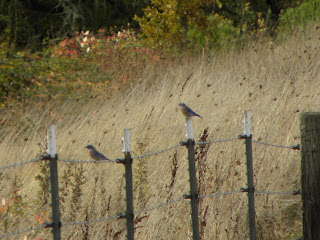

Now I know what birds eat on cold, rainy days in December. At least, some birds. They eat the apples on the tree outside our back door. Or the apples on the ground under the tree outside our back door. Today, from the dry sanctuary of our stair landing, I photographed that tree with Varied Thrushes, Golden-crowned Sparrows, Spotted Towhees and even a Downy Woodpecker in it, although the woodpecker was pecking at the branch not the apples. Here's the scraggly old apple tree with its wonderful apples (my favorites and the birds' favorites, too.) There are at least four birds in this photo. Can you find them?
I'll make it easier. A Golden-crowned Sparrow is in the left bottom quadrant. Another is slightly right of center above a female and a male Varied Thrush. Here they are closer.


Mostly, there were Varied Thrushes. Lots of them. Females with their gray breastbands and males with their black ones... all eating my favorite winter apples.




Other birds came and went (when told to by the thrushes), like this Golden-crowned Sparrow.
And the Spotted Towhee who dove inside this apple.


Even a Downy Woodpecker visited in the fifteen minutes I stood taking photos. Although it had rained all day and was raining then, the only bird looking really damp was the woodpecker. Maybe he was just having a bad hair day.


The ground beneath the tree is littered with apples, too. We've had such an incredibly heavy crop of apples on all our trees that deer, bears, raccoons, coyotes, and every other wild thing on our farm have had more than they could eat on the more distant trees and have not bothered to come into the yard. Our golden delicious tree out front has dumped its apples all over the ground but the birds are not so interested in those. They like my favorite red apples outside my back door, especially now that the weekend wind knocked many down and frost and rain have softened them. I managed to get one bucket full picked and saved in the house before the birds destroyed them.
Here a sparrow is caught in the act... in the center of the photo. And closer here:
But mostly on the ground, as in the tree, eating those delectable apples were Varied Thrushes.
Who? Me?
Tough.
Oh well. Happy holidays, birds!











































